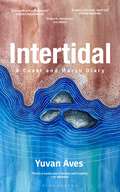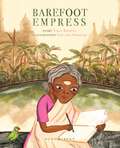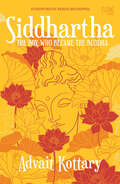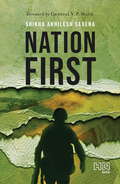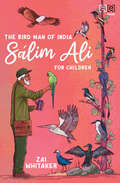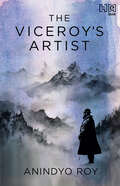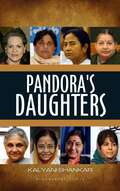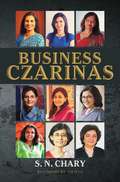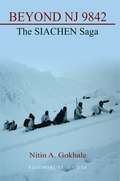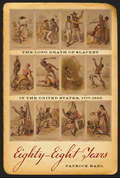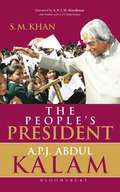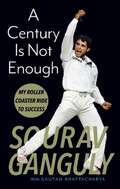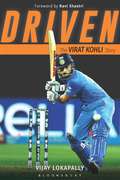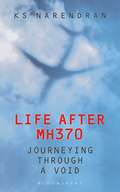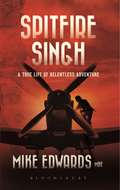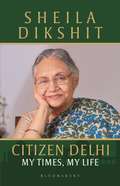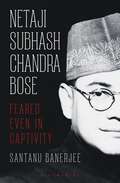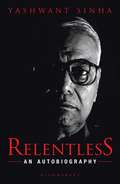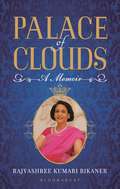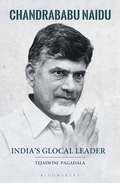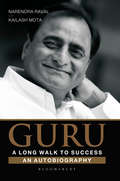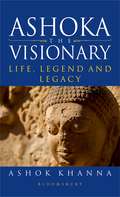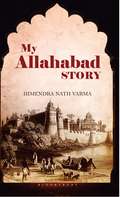- Table View
- List View
Intertidal: A Coast and Marsh Diary
by Yuvan AvesOver two years and three monsoons, Yuvan Aves pays scrupulous attention to the living world of his coastal city. The result is a diary of deep observation of coast and wetland, climate and self. Set in beaches and marshes, and the wild places of the mind, Intertidal comprises daily accounts of being in a multispecies milieu. In language that is jewel-like and precise, we hear frog calls through the night, spot butterflies miles into the ocean, find blue buttons washed ashore, see the churning of longshore currents and meditate on the composting abilities of worms. We also witness communities stand together to preserve the homes and livelihoods of the human and non-human inhabitants of the coast and the marsh. Intertidal asks us to reimagine values to live by in the here and now, heeding the living world and attending to the climate's calling, moving away from the old political, religious and cultural values that have proved to be ecologically disastrous. Yuvan Aves invites us to see beyond the binaries of sea and coast, mindscape and landscape, human and not human, self and other, and live in deep animism amid all of life.
Barefoot Empress
by Vikas KhannaDiscover the life of the remarkable Karthyayani Amma, who went to school for the first time at the age of 96 and surprised the entire country by topping the Kerala government's literacy examination with a record-breaking score of 98 out of 100. Amma hails from Haripad in Alappuzha district, where she swept the streets outside temples in her village for a living. One day, she met Sathi, an educationist, who enrolled her in school. Amma studied hard and stood first, ahead of 43,300 students who appeared for the examination. In 2019 she became a Commonwealth of Learning Goodwill Ambassador. She was awarded the Nari Shakti Puraskar by President Ram Nath Kovind on Women's Day in March 2020. Her inspirational story is proof that it is never too late to realise your dreams.
Siddhartha: The Boy Who Became the Buddha
by Advait KottaryHis family was happy to see him, but they had hoped to meet the Siddhartha they knew, not the Buddha he had become. Long before he became the enlightened leader, he was a boy oblivious of the world. As the young prince navigates politics and relationships, he slowly begins to question his oppressively perfect life. Meanwhile his family struggles to maintain their deception - from banishing the old and sick to hiding their own advancing age - in the hope that they can mould him into a dutiful king. In Advait Kottary's intricately woven narrative, raw human emotion and conflict is tempered with the boundless compassion of the Buddha. Exciting and insightful in equal measure, Siddhartha is at once a riveting story and a profound meditation on our shared quest for truth.
Nation First
by Shikha Akhilesh SaxenaTwo decades after India's resounding victory at Kargil, stories and accounts of the war continue to be narrated with immense pride. Yet, one pertinent perspective has been largely overlooked - that of the army wives. In this remarkable book, Shikha Akhilesh Saxena, wife of artillery officer Captain Akhilesh Saxena, describes the turmoil endured by the families of military officers in the face of conflict.As a young couple, Shikha and Akhilesh unexpectedly found themselves in the midst of war. Shikha deftly depicts her own experiences as well as those of Akhilesh, who took part in missions at Tololing, the Hump and Three Pimples. What does a soldier go through, when marching off to a near-suicidal mission? And what does it take to survive, even thrive, having sustained serious injuries in battle? This detailed memoir shows the boundless bravery of the Indian troops, as well as the emotional tumult experienced by their families both during and after the war. Nation First is a story of grit, determination and heroic patriotism shown by the men and women who give their all to safeguard the country.
Sálim Ali for Children: The Bird Man of India
by Zai WhitakerOF COURSE THERE WERE BIRDS IN THE BUSHES, TREES AND SKIES BEFORE SÁLIM ALI. BUT IT WAS HE WHO PUT THEM ON INDIA'S MAP FOREVER.From being a trigger-happy airgun-toting nine-year-old boy to becoming one of the foremost bird scientists in the world, Sálim Ali did not follow a straight path. Somewhere along his adventures between India, Burma and Europe, he developed such a single-minded zeal for the study of feathered creatures that he spent all his time close to them. Over the long course of researching bird life, in the days when there were no computers or internet, he wrote the first Indian field guide to birds, using just a notebook and binoculars. 'Sálim Bhai' - as he was widely known - had neither wealth nor connections in high places, but his passion for birds, a phenomenal memory and discipline made him one of the most famous ornithologists in the country and beyond. In Sálim Ali for Children, his grand-niece Zai Whitaker brings to life the inspiring story of this brilliant, quirky man who left behind an incredible legacy.
The Viceroy's Artist: A Novel
by Anindyo RoySomewhere in the foothills of the Himalayas, a sixty-two-year-old English painter falls off his sketching stool. Overweight, asthmatic and prone to attacks of epilepsy, Edward Lear is nevertheless on a mission – to paint the mighty Kanchenjunga for his patron, the Viceroy of India.Lear is an oddity, an outsider, simultaneously fascinated and repelled by the world the British have built in India. Even as he battles the fatigue of travelling on pony carts, jampans and trains, Lear reflects on those who run the vast machinery of the Empire – administrators and missionaries, kitmutgars and kamsamahs.Duelling pompous British officers with his wry humour, Lear turns his ear to the polyphony of local languages to compose nonsense poetry with a uniquely Indian flavour. Woven into this vivid account are flashes from Lear's own life – deep-seated fears stemming from an unhappy childhood and the memory of unfulfilled adult relationships. Inspired by the journals of this celebrated artist and poet, Anindyo Roy brings to life Lear's little-known Indian sojourns. In lyrical prose, and occasional verse, The Viceroy's Artist paints a picture of an exceptional man who inspires by his unhindered imagination, curiosity and compassion for the world.
NAUSHADNAMA The Life and Music of Naushad: The Life And Music Of Naushad
by Raju BharatanNaushad is by popular consent the greatest among our film music composers, having been active for 65 years! For twenty years during that period, he ruled the field: from Rattan in 1944, he was the standard against whom every other composer tried to match himself! He didn't have much to show by way of originality after Mughal e Azam (1961), though his music never became base : it was only that the stars for whom he composed declined, the public taste changed, he became trapped in his own image as the custodian of the classical mould in film sangeet. It is a measure of the great man that he steadily refused to succumb to the market pressure. His composing abilities were never in question, but he could not give 'hits" or tunes that would appeal.When he tried to adjust, he was pathetic. Raju Bharatan is such an authority on Naushad and our film music, with so much first hand knowledge and information, a book from him on Naushad is likely to be the last word as an account of his professional life. But this book covers so much more: what the cine music filed was like from inside, how the composers were competing , how they were bad-mouthing Naushad in private, in spite of the show of public bonhomie, what devious games were played to corner awards and limelight, etc. The point is not the filmi world was so dirty; the point is that the composers created great music even in such atmosphere.
Pandora's Daughters
by Kalyani ShankarPandora's Daughters looks at eight prominent women leaders in modern India who have achieved great power in the male-dominated world of Indian politics, examining their traits and personalities, tactics and manoeuvres, strengths and disadvantages and analysing the reasons for their success.With her years of experience in covering national politics, Shankar combines rigorous research and invaluable insight to make Pandora's Daughters essential reading for all who wish to understand politics in India today.
Business Czarinas
by S N CharyBusiness Czarinas features some of the most successful businesswomen in India. Each of their stories is greatly inspiring: their journey to the top; the troubles and obstacles on the way; the opportunities they made the most of; the values they hold dear and the lessons they learnt. Management consultant S.N. Chary interviews nine remarkable women leaders, giving us insight into their work and life. In Business Czarinas these women tell us how they fought-at times for space, in a male-dominated environment-against all odds, with courage and strength. Candid, enlightening and full of practical, first-hand wisdom, these powerful stories make this book essential reading for both men and women.
Beyond NJ 9842: The SIACHEN Saga
by Nitin A GokhaleOperation Meghdoot was launched by the Indian Army on the barren and icy heights of the Siachen Glacier to thwart Pakistan from gaining control of this strategically located glacier. For three decades since then, Indian and Pakistani troops have been locked in an undeclared war on the world's highest – and coldest - battlefield.
Ashutosh Maharaj: Mahayogi ka Maharasya (Bloomsbury Revelations Ser.)
by Mr Sandeep DeoMahayogi Ashutosh Maharaj: The Master and the Mystic is about Shri Ashutosh Maharaj Ji, whose disciples have a firm conviction that he entered the state of samadhi on 28 January 2014. The medical world considers him to be clinically dead but his disciples strongly believe that Maharaj Ji will return to his body at a stipulated time; the reason being, before going into samadhi, he himself had revealed that he will be entering into this state. Not only this, even after assuming this state, he has revealed this fact to his disciples by manifesting in their inner, divine visions a number of times. That's why the disciples of Shri Ashutosh Maharaj Ji have preserved his body in a deep freezer for the last two years. It is an undeniable truth that Ashutosh Maharaj Ji is a secret-revealer, who unveils the divine light of the Supreme Lord within the inner being of his disciples by opening their Third Eye. He initiates his disciples into Brahm Gyan, which has been mentioned in the Vedas and the Upanishads. After all, who is not familiar with the Third Eye of Lord Shiva! Ashutosh Maharaj Ji clearly states that 'first behold God with your own eye (Third Eye), then repose your faith in any Guru.' Today, he has millions of followers all across the world. This is the first book written on Ashutosh Maharaj Ji. This book will reveal to the world as to who is this man who has once again brought into discussion the Vibhutipaad section of the Patanjali Yoga Sutras. The Vibhutipaadsection of the Patanjali Yoga Sutras talks about the different vibhutis (spiritual powers) acquired by a supreme yogi after he exercises his control on nature. One of these powers is the ability to renounce one's body for a long time. This book is an attempt to present the vivid persona of Shri Ashutosh Maharaj ji along with a lucid explanation of the same ancient knowledge, which is soon becoming extinct.
Swami Ramdev: Swami Ramdev ki Pehli aur Ekmatra Jeevani (Bloomsbury Revelations Ser.)
by Mr Sandeep DeoCan you imagine a man on excursion with the mission to inspire .2 million people through the medium of yoga everyday? If Swami Ramdev's movement would have happened in any other part of the world then a lot of universities would have done Ph. D on it! I asked him that we understand that you get energy, health and exaltation from Yoga but please tell us from where do you find the strength to face so many torments from all over.Baba Ramdev went for a mission to promote health of all citizens so that poor people can keep optimum health through yoga and overcome diseases that cannot be cured even through expensive medicines. But while on this mission, he found out that the bigger problem lies within the country than globally with regards to health. Then he started to raise his voice. He is man of determination and once he takes aim, he does not give up until it is accomplished.
The People's President: Dr A P J Abdul Kalam
by S M KhanDr APJ Kalam abolished the practice of having a larger chair for the Rashtrapati on a dias when attending any function He regularly read both the Quran and the Geeta and played the veena and wrote poetry in his spare time His favourite Mahabharata character was Vidura because he had the courage to differ and fight injustice in a peaceful manner Caliph Umar, Mahatma Gandhi, Albert Einstein, Emperor Ashoka and Abraham Lincoln were the five greatest human beings to have lived on this earth according to Dr Kalam The author, SM Khan,acquaints us with lesser known facts and stories which went towards making the great Dr Kalam the 'People's President'. SM Khan was presssecretarytothelateAPJAbdulKalam and shared a unique relationship with the unusual President. The first state visit made by Dr Kalam in 2002 after swearing in as President was to Gujrat where he was received at the airport by the then Chief Minister and now Prime Minister of India, Mr Narendra Modi. Together they visited nine riot-torn areas and three relief camps. Details of this visit as well as those to the other states in India and various trips abroad in the course of his Presidency are captured in this book in a manner that is engaging and informative. Interspersed with interesting anecdotes and happenings, this comprehensive compendium of Dr Kalam's experiences as the President of India finally culminate in his post-presidency days with SM Khan's last poignant meeting with Dr Kalam just a few days before his passing away. A must read for both fans and those who wish to know more about the People's President, Dr APJ Kalam.
A Century Is Not Enough - Novel: My Roller Coaster Ride To Success
by Sourav GangulyIn this part self-development manual, part memoir, Sourav Ganguly takes you through his life. From his difficult debut in Australia to the highs of the Lord’s century, from beating Pakistan on its home ground to the vindictiveness of Chappell – he looks at how to overcome life’s challenges and come out a winner. Time and time again. Honest, straightforward and deeply moving, a century is not enough is both a sporting classic and a manual for living.
Driven: The Virat Kohli Story
by Vijay LokapallyWhat makes Virat Kohli the undisputed monarch of the cricket world today is not his iconic status in the sports hierarchy but that the highest praise comes from the opposition camp and past greats.However, his family didn't always have it good. No stranger to loss, Kohli's biggest support both on and off the field – his father, succumbed to a cerebral stroke when he was very young. In a fitting tribute that would've made his old man proud, Kohli returned to continue an innings just a few hours after his father passed away. 'He was the one who drove me to practice every day,' the captain of the Indian Test team recalls with characteristic humility and grace. Widely travelled sports journalist Vijay Lokapally goes on to recount happier times on the journey of Virat's rapid rise to international stardom, an account punctuated with little-known stories by his fellow players, coaches and intimates. At 27, he has already been the recipient of countless accolades including the Arjuna Award, the title of BCCI's 'international cricketer of the Year' as well as the ICC's 'ODI Player of the Year', but for Kohli it's not about the money or the fame, or the roar of the crowds or the flattering attention from women of all ages. Few know of his altruistic nature and his dedication to numerous charities for under-privileged children. What has not escaped the public eye though, is how this wizard of the willow wears his heavy mantle with such insouciant ease.
Life After MH370: Journeying Through a Void
by Ks NarendranThere are at least 239 stories waiting to be told at length – those of the families of 239passengers of MH370, how their lives took a turn on March 8th 2014 when MH370disappeared.This is the story of one person, Naren, who lost his wife, Chandrika on that flight.The probability of survivors diminished with each passing day. As the months went by,Naren remained pre-occupied, wrestling over what to believe. Some friends arguedinsistently against doomsday conclusions and spoke of their dreams as the basis tokeep up hope. Many others, including Naren's daughter, preferred silence overpredictions. The one argument against which there was no counter was: Where is theevidence? Where is the debris? Where are the passengers?Life After MH370 documents Naren's experience with loss, grief, trauma and sorrow.The struggle with 'ambiguous loss' morphs into a ceaseless search, for the scent of acover-up, for the truth, for that explanation that satisfies and helps one move on. A lossthat meant critically resizing shared dreams, reconfiguring relationships and attemptingto find a purpose that anchor him in the present.There is the hint of a promise in KS Narendran's story – of existential truths about livingand dying that might help anyone who comes upon this book.
Spitfire Singh: A True Life of Relentless Adventure
by Mike EdwardsTheir willingness to pay any price to uphold the honour and integrity of their Air Force meant an uphill battle against bigotry, difficult conditions of work and outdated equipment. However, showing tremendous fortitude, Harjinder and his men took the fight to the enemy and rose splendidly to the occasion. Be it the formidable Japanese, the mighty Germans or the resolute tribal warriors none could break the spirit of these airborne Indians.It is a story of relentless adventure, journeying from the scrublands of the North Western Frontier, to the jungles of Burma, to the UK on the eve of D Day and to the corridors of power in an independent India. The resourcefulness of the Indians and their sheer skill and determination meant that they could overcome the myriad of challenges thrown at them, much to the surprise and dismay of some officers of the Raj. It is a story of mutual respect forged and strengthened across lines of religion, caste, creed and race, as the Indian's undeniable courage and resilience won even the hearts and minds of their British counterparts and one man was the center of it all.Harjinder's is a life of intense friendship, of great ingenuity and of hard-work and dedication, interspersed with the humor and merriment that is ever present in the military environment. It was a bottom to top career for the lowly Hawai Sepoy who went on to become one of the top officers of the IAF. He is credited with the endeavor to make the Indian Air force self-reliant and designed, built and test flew two different aircraft to prove his point. He was one of the driving forces behind making the Indian Air Force the 4th largest in the world, an astonishing feat given the twin challenges of nation building and partition.Thus the only 'disgrace' to emerge from this book is how Harjinder's story could remain untold for so long.
Citizen Delhi: My Times, My Life
by Sheila DikshitThe girl who loved cycling along the tree-lined avenues of a brand new Lutyens' Delhi could never have dreamt that five decades later she would govern, and transform, Delhi as its chief minister – not once, but thrice consecutively.When a politician like Sheila Dikshit, with a career spanning over three decades, chooses to let the reader get a glimpse of her life's journey, the opportunity brings along an element of surprise. In a fascinating account of her life, contoured along the life of the nation and her political party at critical junctures, she creates a richly patterned universe with deft touches, seamlessly moving between the home and the world, the past and the present.Be it encounters with politics, which she terms 'life at its barest' or the ups and downs of a household, what shines through is the portrait of a modern woman determined to face any eventuality with fortitude, and a deep sense of duty.Interestingly, she never wanted to be in politics, but destiny willed otherwise – a destiny shaped by her liberal upbringing in a Punjabi household. Brought up to be independent, she chose her life partner from another part of India. And that started it all.As the wife of an IAS officer and daughter-in-law of well-known freedom fighter and politician, Uma Shankar Dikshit, with his long association with the Nehru–Gandhi family, she saw governance from both ends. When she began assisting her father-in-law from 1969, her up-close view of politics eventually became a springboard for her own entry into the arena in December 1984, inaugurating a 30-year-long career in politics. The narrative foregrounds a question that the author considers crucial for democracy – how does one deal with the constant tussle between the dictates of governance and the here-and-now preoccupations of party politics?
Netaji Subhash Chandra Bose: Feared Even in Captivity
by Santanu BanerjeeThe book tells the reader how after Second World War, Netaji Subhas Chandra Bose, the tallest Indian freedom fighter, slowly petered out in captivity in former Soviet Union, while Kremlin, taking full military advantage of Bose's presence in their land created fear in American and British political and military strategists and among the post-Independence Indian politicians. The research has also been an outcome of British and Indian Government documents and long interviews with senior Indian political leaders. The book is extremely sensitive as the stakeholders are not only big global powers, but the unresolved issue involves the Indian Government which puts a lid on the mystery by sticking to the fake air crash story in 1945 in Taiwan. It is bound to stir up a lot of heat with scholars – especially among, the British, Indian and American, besides exposing the role of the Russians, Indian Communists and the Nehru family that still heads the Congress now.What began as a journey into the unknown, has culminated into this book, an attempt which has taken 32 long years for the author. The research also reveals Bose's socio-political ideology about which he spoke during his Tokyo University speech on the Indian Civilization and how India would have `socialism with a human face.' It also happens to be an issue so far neglected by scholars and historians.
Relentless: An Autobiography
by Yashwant SinhaFrom bureaucrat to politician, and from one century to the next, Yashwant Sinha's incredible journey from modest beginnings to the highest corridors of power is a tribute to a family's determination and sacrifices, a young man's indomitable grit and an enduring ode to a nation in the throes of constant churn and change. Having worked with three prime ministers and two chief ministers, former administrator and union minister Sinha has been a part of the country's transformation from a fledging postcolonial democracy to one of the world's most exciting economies to watch out for-a transformation in which he has played an active role as a parliamentarian, minister for external affairs and two-time finance minister in two vastly different governments. It is also a compelling read for Sinha's commentary on things as diverse as politics, religion, democracy and its institutions, as well as family, personal struggle and a relentless pursuit of bigger dreams. From when bureaucrats often bicycled to work and the back lanes of Bihar to the autobahn of Bonn; from the benches of the Indian Parliament to the podium of the UN General Assembly; from behind the bars of various jails to centre stage as a dissenting voice in a majority government-Relentless tells the story of one of India's most well-known public faces, in his very own unique voice, and some of its most iconic leaders and political parties, with neither fear nor favour. From JP and Chandra Shekhar to VP Singh, Atal Bihari Vajpayee and Narendra Modi, the book gives an insight into the rise and fall of leaders and ideologies that have charted a unique course for our democracy amid fierce personal and political strife.
Palace of Clouds: A Memoir
by Rajyashree Kumari BikanerThis book evokes the romance of the rugged desert kingdom of Bikaner and its Rajput royal family. It is a richly woven tapestry encompassing five generations of an aristocratic family's past and present. Tales of valour, battles and coronations, the splendour of the royal courts, the culture and traditions that made this Rathore state preeminent in the world, all set against the backdrop of imposing palaces, rugged forts and hunting lodges, the magnificence of the gilded age of the Maharajas.The author describes her formative years during the sixties when seismic changes in the world were taking place and which were to take her on an adventurous journey from her home in Bikaner to life in London. The author brings to life a treasure trove of anecdotes and introduces us to a world of elegance, sportsmanship and cosmopolitan culture.
India's Glocal Leader: Chandrababu Naidu
by Tejaswini PagadalaA stereotype image of Nara Chandrababu Naidu has been formed in the last 40 years. His story is remarkable at every level. But often questions, which is the important story? The one where he evolves into one of the extraordinary leaders in Indian politics over four decades? Or that of an ordinary man from a farming family who worked his way to the top by keeping his family and political party together? That which reflects his political acumen, intellect, and hardwork? Or the one that unveils the person who introduced Andhra Pradesh to India? This book attempts to show how Naidu has been a quintessential survivor in Indian politics.This book analyses how Naidu's ability to combine politics and governance has touched every aspect of Indian domestic and foreign policy, from the struggle for social, technological, economic and administrative reforms to creating world-class institutions. It establishes the fact that Naidu, today, is a symbol and an embodiment of many Indias - modern, progressive, rural and cultural.
Guru: A Long Walk to Success:An Autobiography
by Kailash Mota Narendra RavalThe journey of a boy that began from a little-known village of Mathak in Gujarat, India, culminated in the creation of East Africa's biggest business groups to straddle the industrial world of steel, cement, infrastructure and aviation. This is the inspiring story of Narendra Raval, endearingly known as 'Guru', who began from the most humble beginnings to reach the zenith of his career through tireless hard work, an inherent business acumen and sheer tenacity.His autobiography, in collaboration with his dear friend and colleague, Kailash Mota, traces four decades in thelife of Guru Bhai Narendra Raval. It is hard to believe that the astute businessman, who successfully built aUS$ 650 million industrial empire, began his work life as a young, teenage priest in Nairobi, Kenya. Today,Guru Bhai runs his business empire with more than 4,500 employees spread across East Africa. He wasalso featured among the top 50 richest men in the Forbes Africa 2015 list.A fascinating, awe-inspiring autobiography, A Long Walk to Success is a legacy of wisdom and guidance for young entrepreneurs inspiring to walk in Guru Bhai's footsteps.
Ashoka, the Visionary: Life, Legend and Legacy
by Ashok KhannaUngainly in appearance, disliked by his father, the king, but nurtured by his mother, Ashoka worked to elicit his elders' approval. At the age of 18, his father sent him to quell a rebellion that his brother, the crown prince, had failed to do. His success propelled him to be appointed as viceroy of a province. There he met Devi, a beautiful, devout Buddhist. With the death of his father, supported by the chief minister, Ashoka was crowned the new king. Ashoka ruled the Indian subcontinent from 269 bce to 232 bce. After the Kalinga War, a turning point for Ashoka, his devotion to Buddha's teachings became unconditional, and he based his governance on its precepts of non-violence, tolerance and compassion. His support for Buddhism helped it grow from a small sect to a world religion. When it spread to Asia, his model of Dharmaraj was emulated as exemplary kingship by many Asian rulers through history. Prime Minister Nehru, in The Discovery of India, described Ashoka as 'a man who was greater than any king or emperor'. He worked to incorporate Ashoka's secular approach and considerate administration in India's Constitution. As a young democracy, India must adopt both Ashoka's and Nehru's vision of compassionate governance to mature as a nation.
My Allahabad Story
by Himendra Nath VarmaMy Allahabad Story recollects the author's privileged childhood in a prominent family of the city he is obsessed with. He traces his growing years in the large middle class Kayastha family bringing out in amusing detail, some quaint social customs and traditions that existed half a century ago.The author wonderfully describes the changed complexion of the city with a tinge of despair. Life and times and what happened to Allahabad has been graphically described with nostalgia. An interesting account of an Irish resident brings out the social life that prevailed in Allahabad hundred years ago, interlaced beautifully between the English, Anglo-Indians and Indians.
